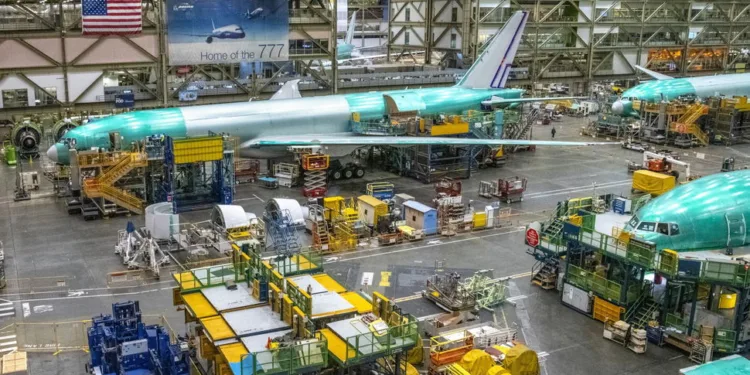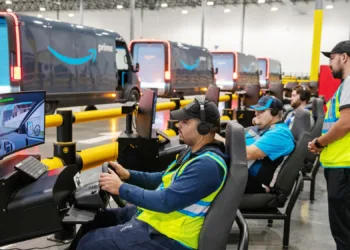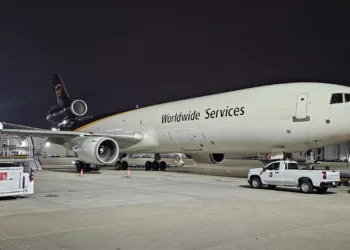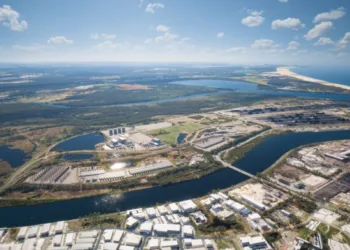Boeing on Monday officially began production of the 777-8 freighter by drilling the first hole into a wing spar, while Airbus reached another milestone in building its new A350 freighter as the companies gear up competition for sales of large cargo jets.
The developments come after Boeing (NYSE: BA) recently downgraded its 20-year forecast for air cargo volumes to 3.7% compounded annual growth from 4.1% in its 2024 commercial market outlook. Boeing also predicts total freighter aircraft entering the market by 2044 will be 2,900, up slightly from the 2,845 projection in last year’s report.
The lower traffic forecast reflects a higher annual growth in the 2024 base year of 11% and lower long-term economic estimates, Boeing spokesman Ted Land explained. The airfreight market experienced a strong recovery in 2024, driven by cross-border e-commerce demand, after an 18-month downturn.
Boeing projects a 67% increase in the global freighter fleet by 2044, including 885 large widebody aircraft like the 777-8 and the A350 — up from 810 in the prior estimate. Total freighter production increased by 55 units despite a drop of nearly 100 narrowbody freighters over 20 years.
Boeing attributes the change to growing demand for the payload and range of widebody cargo jets to support increased supply chain diversification and cross-border e-commerce at a time when airlines are accelerating retirement of older aircraft, new production has been slowed by post-pandemic supply chain backlogs and government certification for emerging 777 conversion companies has been delayed. Meanwhile, the market is oversupplied with narrowbody converted freighters.
The analysis shows fewer factory-built freighters entering service than estimated last year, with 955 newbuilds versus 1,945 passenger-to-freighter conversions.
777-8 production begins
The U.S. aerospace giant announced that manufacturing of the first 777-8 freighter began Monday at a plant in Everett, Washington, with a specialized robot drilling holes in the wing spar and filling them with fasteners. Spars are the backbone of a wing, serving as a critical support structure. Each wing has two spars — one in the front and one in the rear.
The 777-8, now scheduled for first commercial delivery in 2028, will be the world’s largest twin-engine freighter. Boeing says the plane will have 30% better fuel efficiency and emissions, with nearly identical payload and range capabilities, compared to the aging 747-400. The 777-8 also offers 25% better operating costs per ton and much quieter engines. Technical specifications include a maximum revenue payload of 123.7 U.S. tons, with main-deck capacity for 31 pallets, and a maximum range of more than 4,400 nautical miles.

The 777-X program, which includes a passenger variant, was launched more than a decade ago, but has faced a series of technical and regulatory delays. The company began taking orders in January 2022 and now has 59 firm orders. Qatar Airways is the launch customer, with a firm order for 34 aircraft. Other 777-8 customers include Lufthansa, Silk Way West, Cargolux, ANA and China Airlines.
To make the 108-foot long composite spars, Boeing machinists in the Wing Center guide machines that apply layers of carbon fiber tape onto large tooling to form the shape of the spar, which is then prepped and hardened through pressure and heat in an autoclave. The spars are then moved onsite for finishing work before they are moved to the main Everett factory.
Airbus stays one step ahead
Meanwhile, Airbus announced Wednesday that it has completed manufacturing the first horizontal stabilizer for the A350 freighter at its plants in Spain. The section will be shipped to the Airbus final assembly line in Toulouse in the coming weeks, where it will be joined with the fuselage of the first test aircraft. Airbus is manufacturing two A350 cargo jets for flight testing in 2026 and 2027.
In late May, Airbus finished the first ever set of wings for the A350F.
Airbus benefits from an efficiency standpoint by building the horizontal stabilizer and wings in the same production lines as the passenger version.
The manufacturer has received 66 orders for the A350 freighter. It expects to begin first deliveries in late 2027 after development delays of its own.
The A350’s main-deck cargo door will also be manufactured in Spain. Made from composite materials, it has the largest door opening of any freighter to make loading and unloading faster and easier.
Airbus says the A350 will offer at least a 20% reduction in fuel consumption and CO2 emissions compared to large cargo aircraft currently in service. The widebody freighter has a payload of up to 122 tons and a range of up to 4,480 nautical miles.
Click here for more FreightWaves/American Shipper stories by Eric Kulisch.
Write to Eric Kulisch at [email protected].
RELATED STORIES:
Saudi Arabia-based leasing company to buy 10 Airbus A350 freighters
Airbus postpones rollout of A350 freighter until late 2027
China Airlines finalizes deal for 4 Boeing 777-8 cargo aircraft
The post Boeing raises outlook for widebody freighters as 777-8 production begins appeared first on FreightWaves.






















